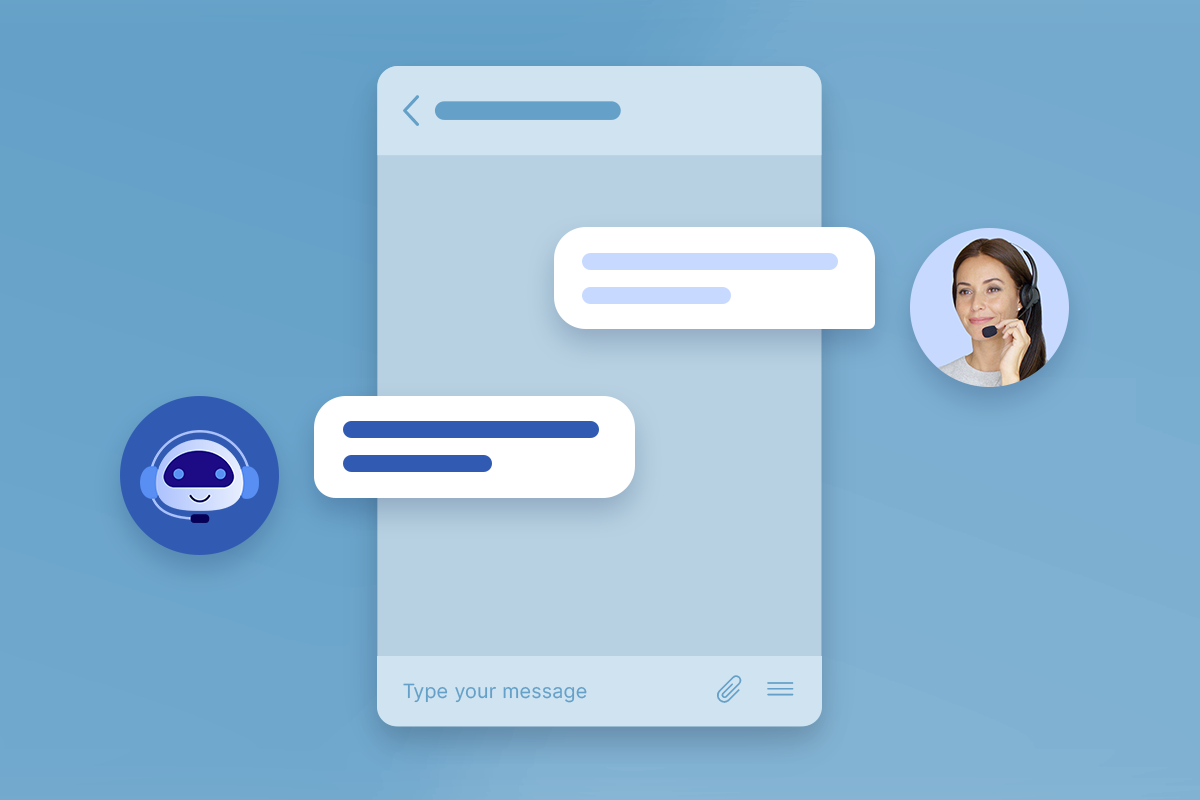How often do you interact with brands online? In-person?
Brand interactions now happen online more often than they do in-person. Salesforce projected that in 2022, 61% of company interactions would be online, and only 39% would be in person. That number has been steadily increasing since 2020.
With more people spending more time in front of their screens (whether mobile or desktop), customers need a convenient place to connect with your business.
And your website is a good place to start.
Live chat (also known as web chat) is the simplest way to connect with your customers online. It usually involves a chat feature that lives on your website where customers can instantly start a real-time conversation.
So, where do chatbots come into play? We get it—with all the jargon thrown around, it can get confusing. (What happened to the days of customer service by phone or email, right?) While live chat is the method of communication, chatbots are the ones doing the communication.
Let us explain.
Say you need to contact an e-commerce company to return an ill-fitting shirt. (Too long, too tight, too orange…whatever the case may be.) Even though it’s a simple transaction, you still need to request a return label. So you go to their website, open the live chat box and type in your request.
You’ll likely get a chatbot responding to your inquiry and helping you through the process.
Chatbots, like the AI-powered ones we implement for our customers, often stand in for live agents when interacting with customers.
But it’s not as simple as implementing live chat, finding a low-fidelity bot, and putting it to work. It takes careful planning and, above all, a fierce customer-first approach to successfully implement a chatbot strategy.
Continue reading as we compare live chat to chatbots, when to use each of them (or both), and how to navigate the customer service experience.
Why live chat is a must.
Where phones used to be the easiest and fastest way for customers to reach you, live chat is quickly replacing it. Live chat is a communication channel where customers can get immediate answers to their questions.
Now, 42% of customers prefer online chat (another name for live chat in this instance) over other communication methods, according to Salesforce’s State of the Connected Customers Report.
Compared to other forms of customer service, live chat frequently performs better, with faster response times, higher CSAT scores, and quicker resolutions.
Plus, your customers are more likely to return to a website that offers live chat, according to 63% of respondents, reports SaaSworthy.
Why should you use chatbots for customer service?
Customer expectations are increasing. While at the same time, your customer service team is asked to do more with less. Something has to give. Or does it?
Chatbots build a bridge between your stellar customer service team and your customers. When comparing live chat and chatbots, don’t think of them as adversaries. Chatbots aren’t replacement tools for human interaction but merely extensions of your customer service team.
- Here are just a few things chatbots can do:
- Answer customer questions.
- Troubleshoot common problems.
- Gather customer information.
- Determine the department to route customers to.
- Move customers into an agent’s queue across channels.
In fact, 48% of U.S. customers believe AI should make life easier, according to Zendesk’s CX Trends Report. For people ages 25–39, that number jumps up to 80%.
How to make your chatbot stand out using live chat.
The biggest problems you’ll face when implementing a chatbot strategy for customer service are perceptions and expectations.
On one side of the spectrum, many people have high expectations for AI. Pop culture has skewed public perception, making them think AI can do nearly anything seamlessly without much work on their part.
On the other side, some people simply hear (or see) the word “bot” and dismiss it as stupid and useless. (Probably from previous bad experiences with low-end, faulty bots.)
There’s currently a long way to go before AI-powered chatbots meet customer expectations. Here are a few ways AI chatbots are failing customers—and how you can use this information to make your customer service stand out.
Accuracy is everything.
The stat: 47% of consumers report not getting accurate answers, according to Zendesk.
As an extension of your customer service team, customers need to be able to trust the information they get from your chatbot. Customers who don’t trust your chatbot quickly lose faith in your business.
While we like to think that AI is infinitely intelligent, chatbots are only as good as the information you feed them. Just like you have to spend time straining your customer service agents, you need to spend time inputting information, writing scripts, and QA-ing your chatbot.
How to fix it: Ensure your chatbots have access to all the information your customer service agents do, including product databases and customer data.
Speed still matters—even if your agents’ time isn’t at stake.
The stat: 56% of customers say it takes too long for the bot to recognize it can’t help solve their issues.
It’s like listening to the five-minute interactive voice response (IVR) menu before realizing you need to talk to a representative. Forcing customers to answer too many questions or go through too many routing menus is an easy way to frustrate them. Especially when 48% of surveyed consumers in the U.S. believe chatbots should save time when contacting a company.
How to fix it: While it’s a good practice to use chatbots to collect information before connecting with a live agent, keep them as few as possible.
Also, consider measuring chatbot performance, much like you would a live agent. Are they resolving issues quickly? Are they able to solve problems with just one interaction? That way, you can identify weak spots and continue improving.
Don’t make customers repeat themselves, ever.
The stat: 44% of customers say the most frustrating thing about working with a chatbot is when they have to start all over again with a human agent.
We know customers hate to repeat themselves. It’s one of the things they hope AI-enabled bots can prevent. According to Zendesk, 49% of surveyed consumers believe AI should keep people from having to repeat themselves.
How to fix it: When combining live chat and chatbots, make the handoff from bot to agent seamless. Use the information collected by the bots to auto-populate your conversational platform and give agents access to the conversation so they don’t miss anything.
Be transparent and give them a choice.
The stat: 44% get frustrated that they don’t have a choice between speaking with a human or a bot at the beginning of a conversation.
Think about IVR systems. They (almost) always give you an option to connect directly with a live representative, and it’s easy to tell when you’re talking to a live agent.
But it’s not as easy to identify over live chat, and customers can feel deceived when they think they’re reaching out to a person. And when they’re having a hard time explaining their issue, walking through it with a bot can just add to their frustrations.
How to fix it: Name your bot, and have them introduce itself as a robotic assistant. Include an option to connect directly with a live agent (when available) in that welcome message. While you want to encourage customers to interact with your bot in order to reduce the burden on your live agents, you don’t want to force them. Give them a choice.
Infuse bots with brand personality.
The stat: 47% of surveyed consumers believe AI should improve customer service quality.
Admittedly, you’re battling a perception when introducing chatbots into your customer experience. When customers hear “chatbot,” they immediately think of robotic, monotone voices. For web conversations, that translates to personality-less text or poor attempts to sound “human” that end up sounding… fake.
The easiest fix is to create a chatbot experience that matches your brand’s personality, whether that’s enthusiastic, fun, empathetic, or straightforward.
Our client Daily Harvest, a popular meal kit delivery service, knew they needed to create a chatbot to help alleviate their overburdened customer service team. But they wanted to ensure customers got the same excellent customer experience the brand has become known for. They partnered with Quiq to build a custom AI chatbot that not only solved common customer issues but could also interpret customers’ language and syntax, their food preferences, and more.
They ended up with Sage, Daily Harvest’s digital care guide. Besides reducing call volume by 60% (a huge win in its own right), they optimized the customer experience and improved their already extraordinarily high CSAT rate.
Read more about Sage and Daily Harvest here >
Make live agents and chatbots part of the same team.
With the right planning (and the right partner), chatbots and live agents can work seamlessly together to serve your customers.
According to Zendesk, only 38% of businesses use both bots and human agents for live chat. That means there’s a big opportunity for improvement.
Since 83% of customers expect to connect with someone immediately when contacting a company, according to Salesforce, you need to pool your resources to meet (or exceed) customer expectations.
Start crafting your chatbot and live chat strategy by taking these preliminary steps:
- Collect customer issues by volume. What questions do you get the most?
- Organize them by complexity. Are they simple “where’s my order” questions, or do they take several steps and individual problem-solving?
- Identify which can be solved with bots or which needs a live agent.
- Figure out how bots and humans can work together to solve problems.
Don’t think of live agents and bots as working in silos. The best tactic is to use them both together at various times in the interaction.
Use a bot to collect information and troubleshoot problems upfront. Then, tap in a live agent when the problem gets complex. You can also pull in a bot at the end of the conversation to close out transactions, ask for feedback, or talk about the next steps.
Empower your customer service team to embrace chatbot interactions, and work in tandem to deliver the best customer experience.
Leverage live chat and chatbots with Quiq.
Quiq’s AI-powered chatbots work just like your live agents. With our Conversational Platform, you can combine native Quiq customer service chatbots, bots developed in third-party frameworks, and human agents any way you like.
The question is no longer if you should choose between live chat or chatbots, but how you can use both to deliver the ultimate customer experience.




